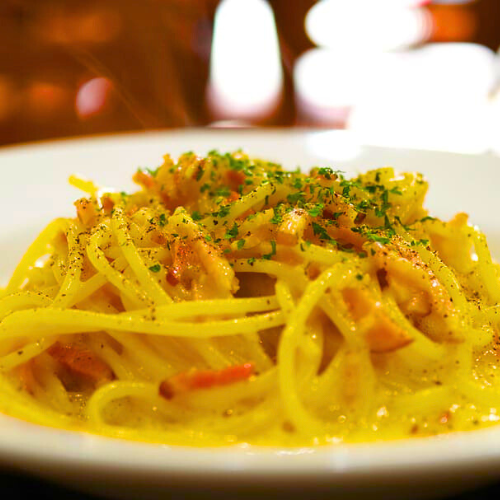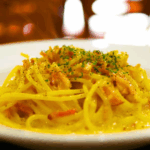What is the Origin of the Carbonara Recipe? A Complete History
What is the Origin of the Carbonara Recipe? Carbonara is one of the most beloved Italian pasta dishes, known for its creamy texture and savory flavor. But despite its worldwide popularity, its origins remain shrouded in mystery and subject to much debate among culinary historians and chefs. In this article, we will explore the origins of the carbonara recipe, debunk common myths, analyze historical sources, and trace how this humble dish became a global icon.
Introduction: The Global Fascination with Carbonara
Spaghetti alla Carbonara is a staple on Italian restaurant menus across the globe. Its key ingredients—pasta, eggs, cheese, guanciale (cured pork cheek), and black pepper—are deceptively simple, yet come together in perfect harmony.
But where exactly does carbonara come from? Did it originate in Rome, the heart of Lazio, or was it an invention influenced by foreign powers? This guide will walk you through all the key theories, historical records, and cultural contexts that inform the history of carbonara.
Table of Contents
- Defining Carbonara: The Core Ingredients
- Earliest Mentions of Carbonara
- Theories on the Origin of Carbonara
- The American Soldier Theory
- The Coal Miners’ (“Carbonari”) Theory
- Evolution from Other Roman Dishes
- First Documented Recipes
- Carbonara’s Evolution in Italian Cuisine
- The Global Spread of Carbonara
- Modern Interpretations and Variations
- Debunking Common Myths
- Why Carbonara Continues to Captivate the World
- Conclusion
- FAQ: All About the Origin of Carbonara
1. Defining Carbonara: The Core Ingredients
Before diving into its origins, it’s essential to define what makes a pasta dish a “carbonara.”
Traditional ingredients:
- Pasta (usually spaghetti, rigatoni, or fettuccine)
- Egg yolks (some use whole eggs)
- Guanciale (or sometimes pancetta in adaptations)
- Pecorino Romano cheese
- Freshly ground black pepper
Notably, no cream is used in authentic Italian carbonara, although many international variations mistakenly include it.
This combination creates a luscious, creamy sauce, achieved solely through emulsifying the egg with pasta water and rendered pork fat.
2. Earliest Mentions of Carbonara
The first known mention of “pasta alla carbonara” dates to the mid-20th century, which surprises many who assume it’s an ancient Italian dish.
Key milestones:
- 1944-1945: Some food historians point to the Allied Liberation of Rome as a crucial moment, with American soldiers allegedly influencing the dish’s creation.
- 1950: The first official Italian recipe for carbonara appears in print in the magazine La Cucina Italiana.
- 1954: The Roman cookbook La Signora in Cucina by Maria Luisa Incontri includes a carbonara recipe.
Despite its relatively modern appearance, many believe carbonara evolved from older, rural recipes.
3. Theories on the Origin of Carbonara
Several theories attempt to explain the true origin of carbonara. Let’s examine the most prominent ones.
3.1. The American Soldier Theory
This theory posits that carbonara was created after World War II, during the Allied occupation of Italy.
- American soldiers brought powdered eggs and bacon as part of their military rations.
- Italian cooks, using these ingredients and traditional pasta, crafted a new dish that eventually evolved into the carbonara we know today.
- The proximity of Rome to military operations makes this theory plausible.
Supporting evidence:
- Similarities between carbonara and American-style breakfast flavors (eggs and bacon).
- Sudden rise of carbonara recipes in the post-war period.
Criticism:
- Some culinary purists dismiss this as an “Americanized” origin story, preferring an Italian-centered explanation.
3.2. The Coal Miners’ Theory (“Carbonari”)
Another theory links carbonara to the “carbonari”, or charcoal makers in central Italy, particularly in Lazio and Abruzzo.
- The name “carbonara” could derive from “carbonaro”, meaning a person who makes charcoal.
- These workers often prepared simple, rustic meals using shelf-stable ingredients like dried pasta, cured pork, and hard cheese.
- Black pepper flecks resemble specks of coal, further supporting this metaphorical link.
Challenges:
- No direct historical records or recipes explicitly link the coal miners to the carbonara dish.
- The “carbonari” were also a political movement in 19th-century Italy, adding layers of complexity to the etymology.
3.3. Evolution from Other Roman Dishes
Some food historians argue that carbonara is simply an evolution of existing Roman pasta traditions, notably:
- Cacio e pepe: Pasta with cheese and pepper.
- Gricia: An older Roman dish featuring pasta, guanciale, and pecorino cheese but no eggs.
- Amatriciana: Pasta with guanciale and tomato sauce.
The theory suggests that adding eggs was the final innovation, creating a richer, more indulgent dish.
Supporting points:
- All these dishes rely on pecorino Romano and guanciale, staples of Lazio cuisine.
- Roman culinary culture prizes frugality and simplicity, consistent with carbonara’s ingredient list.
4. First Documented Recipes
The first formal recipes for carbonara begin appearing in Italian cookbooks and magazines in the 1950s.
Notable early sources:
- La Cucina Italiana (1950) featured a version with cream, although modern purists exclude it.
- Il talismano della felicità by Ada Boni (1950 edition) did not originally include carbonara, but later editions referenced it.
- By the 1960s, carbonara had cemented itself as a staple in Roman trattorias and family kitchens.
Key takeaway: While theories abound, historical records indicate carbonara emerged no earlier than the 1940s, making it a relatively modern classic.
5. Carbonara’s Evolution in Italian Cuisine
From its post-war emergence, carbonara quickly spread throughout Italy, with regional variations.
Roman standardization:
- The classic Roman recipe is strict: guanciale, pecorino, eggs, and black pepper—nothing more.
- Pasta shapes most commonly used: spaghetti and rigatoni.
Regional deviations:
- Northern Italian versions often incorporate butter or cream, though traditionalists disapprove.
- Southern Italian cooks sometimes use pecorino with Parmigiano-Reggiano.
Italian culinary authorities, including Accademia Italiana della Cucina, have sought to document and codify the authentic carbonara recipe to preserve its heritage.
6. The Global Spread of Carbonara
By the 1960s and 1970s, carbonara had made its way into international cuisine, particularly in:
- The United States
- United Kingdom
- Australia
However, adaptations often introduced cream, onions, garlic, and even mushrooms, diverging significantly from Roman tradition.
Why did it spread so quickly?
- The global fascination with Italian food post-WWII.
- Carbonara’s ease of preparation and affordable ingredients.
- Italian immigrants introducing the dish abroad.
7. Modern Interpretations and Variations
Today, chefs and home cooks worldwide create both authentic and innovative takes on carbonara.
Popular variations:
- Using pancetta instead of guanciale.
- Adding cream, onions, or garlic.
- Swapping pasta types (e.g., linguine, fettuccine, or bucatini).
Gourmet adaptations:
- Michelin-starred chefs experimenting with truffle shavings or duck eggs.
- Vegetarian or vegan versions substituting cured pork with smoked mushrooms or plant-based bacon.
While purists argue for fidelity to tradition, others celebrate carbonara’s versatility as a culinary canvas.
8. Debunking Common Myths
Myth 1: Carbonara is centuries old.
Fact: Evidence suggests it emerged only in the mid-20th century.
Myth 2: Cream is essential for carbonara.
Fact: Authentic Italian carbonara never includes cream. The creamy texture comes solely from eggs and cheese.
Myth 3: Carbonara is named after charcoal or coal.
Fact: While plausible, there’s no definitive evidence linking the dish’s name to coal miners. Linguistic coincidence or metaphor may be at play.
9. Why Carbonara Continues to Captivate the World
- Simple ingredients, universally available.
- Perfect balance of salty, creamy, and umami flavors.
- A dish that requires technique, despite its simplicity.
- Continues to inspire chefs and food lovers worldwide.
10. Conclusion
The origin of carbonara remains partially shrouded in culinary lore, yet most evidence points to its post-WWII emergence in Rome, likely influenced by both local traditions and foreign ingredients.
Whether a coal miner’s lunch, a soldier’s improvisation, or an evolution of Roman classics, carbonara is now indisputably a global icon of Italian gastronomy.
For those seeking authenticity, remember: no cream, only eggs—and always use guanciale if you can.
11. FAQ: All About the Origin of Carbonara
Q1: When was carbonara invented?
A: Most food historians agree that carbonara was created in the mid-1940s, likely around 1944-1945, in the wake of World War II.
Q2: Is carbonara an ancient Roman dish?
A: No. Despite its Roman roots, carbonara does not date back to ancient times. Its first documented mentions are from the 20th century.
Q3: Did American soldiers invent carbonara?
A: It’s one popular theory that American military rations (bacon and powdered eggs) inspired Italian cooks to create carbonara after WWII. However, this remains unproven.
Q4: What does “carbonara” mean?
A: The term may derive from “carbonaro” (Italian for coal burner or charcoal maker), but there’s no universally accepted explanation for the name.
Q5: Is it authentic to add cream to carbonara?
A: No. Authentic Italian carbonara does not include cream. The creamy consistency comes from eggs, cheese, and pasta water.
Q6: Which pasta is best for carbonara?
A: Traditionally, spaghetti or rigatoni are used, though other pasta shapes can work.
Q7: What is the most essential ingredient in carbonara?
A: While all ingredients are crucial, guanciale (cured pork cheek) is key for authentic flavor.
Q8: Is carbonara originally from Rome?
A: Yes, most evidence ties carbonara’s origins to Rome and the Lazio region of Italy.
Q9: Are there vegetarian versions of carbonara?
A: Yes, many chefs create vegetarian carbonara using mushrooms, smoked tofu, or other meat substitutes, but these are modern adaptations.
Q10: Why is carbonara so popular globally?
A: Due to its simple yet delicious ingredients, ease of preparation, and the global popularity of Italian cuisine.
Interested in more Italian food history?
Check out our articles on:
Final Words
Understanding the origin of the carbonara recipe adds a layer of appreciation for this iconic dish. Whether you’re a home cook or a food historian, the story of carbonara exemplifies how food can embody culture, history, and innovation all at once.
Did you enjoy this deep dive into carbonara’s history? Share your favorite carbonara experience in the comments below!




